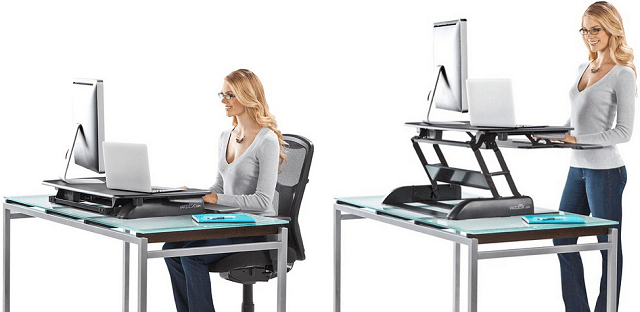Last updated on March 7th, 2019
Best Sitting Posture

This article explores the best sitting posture. As a nation we do a lot of sitting. A dozen studies or more support the undeniable truth that sitting for long periods of time increases your chances of diabetes, obesity, spinal degeneration, and even shorten your lifespan by 50%(1)!
While we can’t always avoid sitting we can find the best and most correct way to sit. Proper sitting position will reduce pain, improve posture, mitigate common postural distortions such as forward head posture and maximize productivity(2).
Sitting Posture at WorkStations
Working with a desktop computer means there is a specific orientation between the monitor, keyboard, desk and chair that is different than a laptop. To sit ergonomically correct follow the “90 degree” rule:
- Sit up straight so your torso is 90 degrees to the floor
- Set your monitor to eye level
- Move your body to the desk so that your arms are slightly tucked in
- The forearm is 90 degrees to your upper arm
- If at this stage your feet are off the ground get a floor foot rest platform to place below your feet so that your legs are at >90 degrees to your torso
- Your wrists need to be straight and supported by a pad

Workstation Standing Desks
One very good option is a combo approach of sitting and standing desks. It takes your workstation and allows you to sit and stand without having to move all your hardware.
One company that is leading the way in affordability and versatility is Varidesk. Set up is easy. Employers will cover the cost for a unit like this because it supports proper ergonomics and improves productivity(3). The point is to get you to move more and not be in one position for too long. Learn more about best workstation here.

Chair Alternatives
The great thing about a kneeling chair is it increases the angle between your torso and your legs. This position serves to alleviate the stress on your spine as well as lengthen the hip flexor muscles that are commonly associated with back problems.

Sitting Posture at Laptop
The laptop lends itself to serious bad posture scenarios. The monitor is mechanically designed to low and forces the user to slouch and look down for long periods of time. The posture that develops over time is called forward head posture. The best solution for the best sitting posture at a laptop is to use a portable laptop table – like the one created by Avantree to raise your monitor. Add a mouse and keyboard with wire or bluetooth.


Sitting Posture in Car
The best car posture is about aligning your body while still maintaining your safety. This includes aligning your head and shoulders while supporting your low back.
Head & Shoulders
For safety reasons it is important to keep your head no more than 2 inches from the headrest and the top of your head should not be higher than the headrest. Align your ear with your shoulders. Set the back of seat so that you can reach the wheel and still have the upper arms relaxed and not over extended.
Back and Hips
The goal is to lift the rib cage and avoid the low back from collapsing toward the seat. Add support such as a pillow that can be shifted from lower back to below mid-back. Learn more about the best car posture.
Seat
Deep bucket seats can lead to tilting of pelvis. Uneven pressure on your hips and tail bone are alleviated with a supportive cushion.
Products to improve sitting posture
For your workstation:
- Standing Desk Varidesk
- Table for Monitor
- Ergonomically friendly Chair – see our review here
- Wrist Mouse pad
- Floor Foot Rest platform
For your laptop:
For your car:
- Everlasting Comfort’s Memory Foam – Low back support
- Ziraki Orthopedic Cushion
Back Brace Support:
Postural braces are effective ways to help keep you upright while sitting. You can see a list of Posturepossible’s favorite back braces on our page: Posture Brace Comparison. An effective posture device is helpful when you can’t get out of sitting for long periods of time. They help reduce fatigue and are effective for correcting slouching posture (4). A posture device acts as great reminder to sit up straight.
Bottom Line
Proper sitting position can alleviate many conditions related to poor sitting posture. Follow the tips above to help improve your overall posture. Also, change positions every 15-20 minutes. Whether at a sitting desk or standing desk or a combination you need change positions often.
References:
(1) Mortality and posture. Kado et al 2005, Cancer, heart disease and Type 2 diabetes. Levine, 2013

Dr. Paul Paez, DC, NRT, NET, CMT
National Board Certified Doctor of Chiropractic (DC), trained in clinical nutrition (NRT), neuro-emotional release (NET), and Massage Therapy (CMT). Dr. Paul holds the rare triple distinction of Certified Posture Expert, Certified Posture Neurologist and Certified Posture Ergonomist by the American Posture Institute. Posture Possible is the very best resource for posture information.




